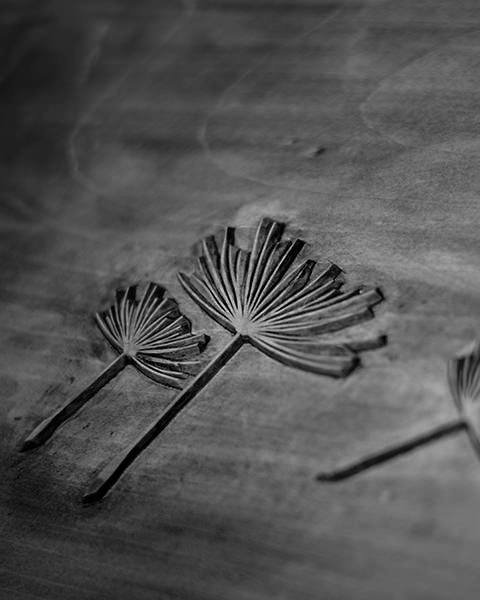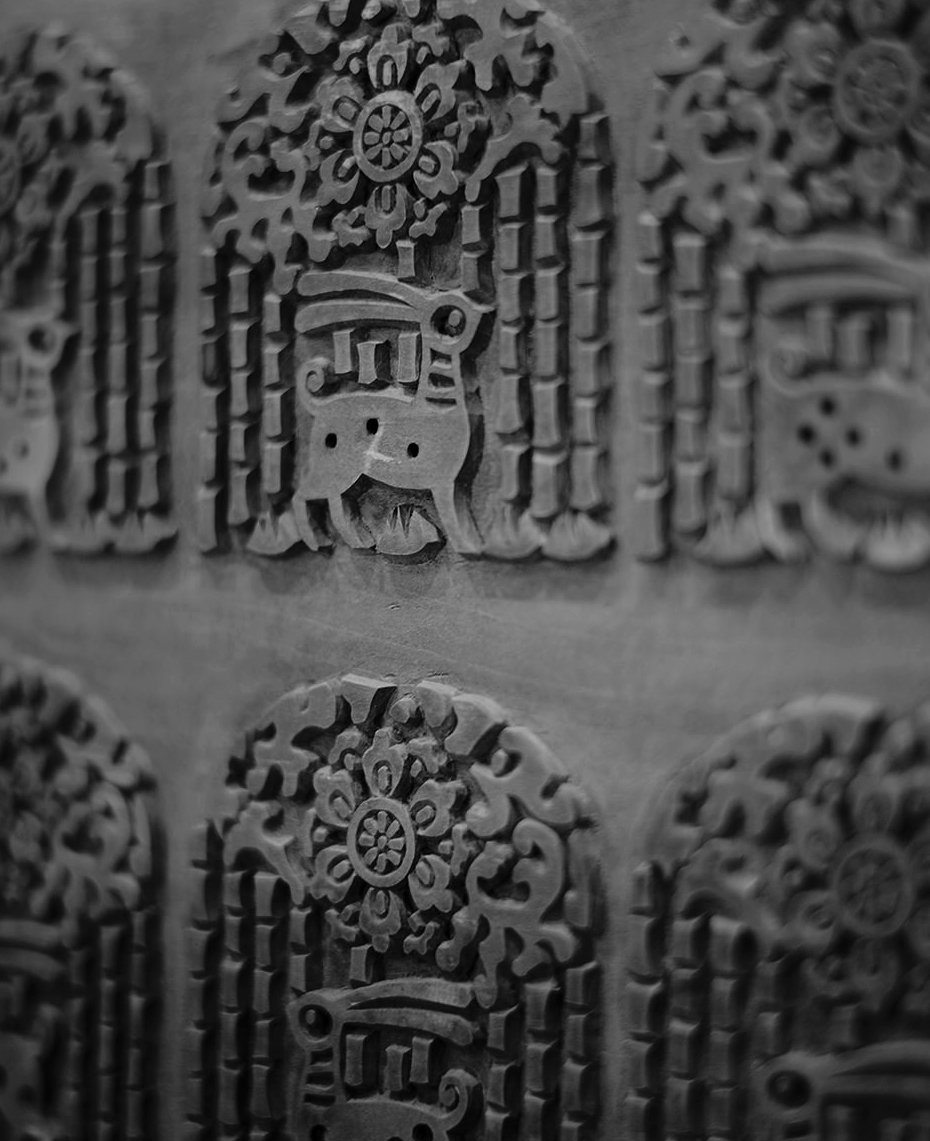in the 100 Pattern project.
A new light comes around, illuminating the old.
What have we protected? What have we created?
Founded in 1624, Karacho is the last remaining karakami shop in Japan. As the inheritors of this history and culture, we at Kira Karacho have resolved to create 100 new woodblocks to add to the over 600 woodblocks that have been preserved and passed down to us by our ancestors.
We named this project “The 100 Patterns of Heisei” to express our intent to create 100 patterns filled with the prayers, wishes, and stories of people living in 2019, the final year of the Heisei era. Our aim was to pass on this culture spanning the Heisei and Reiwa eras to people living in the future 100 years from now, together with the karakami patterns that have come down to us, nurtured over the four centuries that came before.
We have selected 100 patterns from three categories: Karacho patterns, patterns made in collaboration with the people below, and patterns submitted by members of the general public. Our idea was to embrace change and diversity, and then pass it through the filter of our own hands, thereby strengthening Karacho’s novel tradition.
Through the diffusion of the culture of Karacho, the Heisei no Hyakumonyo Project (the 100 Patterns of Heisei) aims to spread Japanese culture and continuously create a history of tradition and succession, as well as circulation and rebirth. It seeks to be a sustainable cultural project that will be meaningful to Kyoto 100 years from now.
As we stand on the cusp between the Heisei and Reiwa eras, the 100 Patterns of Heisei project will evolve into the 100 Patterns of Heisei and Reiwa project, incorporating the names of both eras.
- 2023.04.07Hyakumonyo Project
同志社大学GR学部/公式ロゴ制作のご案内
同志社大学グローバル地域文化学部(GR)より、学部開設10周年にあたり、ロゴ制作依頼を受けました。ロゴを生み出す元を文様として捉え、学部コンセプトに呼応するコラボ レーション文様を平成令和の百文様の一つとして創出し、その文様の象徴部分をGR学部の公式ロゴとなるようにデザインしました。
志の交わるところ/Kokorozashi no majiwarutokoro
平成令和の百文様(開板/令和五年如月)
同志社大学グローバル地域文化学部(GR)とのコラボ レーション文様であり、象徴部分はGR学部の公式ロゴにもなっています。 多種多様なる人びと、地域、国、文明が時代を超えて交わる中で生まれる価値が、希望の光として広がり循環してゆくことを願いクルスと渦巻きを組み合わせました。G(世界)は、R(地域)に包まれており、光と多様性を表す十字と、呪術的な渦巻きR を影日向パターンとして組み合わせ、美しいステンドグラスの光をイメージし文様化したものです。魔除けを表す格子文様で守られた志と思いが混沌の世界に放つ光となることを願います。(文様説明/トトアキヒコ)


- 2023.04.05Hyakumonyo Project
inquire/掲載記事を追加しました
Deep Care Lab主催の「Weのがっこう」に2022年10月28日〜29日にかけて「わたしと未来・子どもたち」というモジュールが開講され、百年後を見据えて立ち上げた平成令和の百文様プロジェクトについて語ってほしいとの依頼があり、唐紙師トトアキヒコが登壇しました。主題は「現代に生きるわたしたちが未来に遺せる種とは」です。講義に参加されたライターさんがinquireに記事を投稿してくださいました。
◎inquire掲載記事
希望の種は、未来に信じて託す。400年の伝統をつなぐ唐紙師の「祈り」の姿勢
The 100 Patterns of Heisei and Reiwa
◎Publication Articles: inquire
希望の種は、未来に信じて託す。400年の伝統をつなぐ唐紙師の「祈り」の姿勢
The Heisei Reiwa no Hyakumonyo Project
Ki no Tea

Shojugonomi Genjiko

Honebamitoushiro

Heart & Cupid

Omoi no Take Meguru Tsuki

Alleluia

Hyaku Monyo Mon

Monju no wa

Houjoue

Hinata Daimon

Kage Daimon

Toraya Yokan PatternKARACHO Selection

Tsurunoko Reiwa

Shushi

Kouha

Fujin Karakusa

Gekka

Rose arabesque mum

Souran

Hikari No Ame

Kokorozashi no majiwarutokoro


We are currently carving the 54nd woodblock in the 100 Pattern project. (Some items are still in production)
- Ki no Tea
- Shojugonomi Genjiko
- Honebamitoushiro
- Heart & Cupid
- Omoi no Take Meguru Tsuki
- Hinata Daimon
- Kage Daimon
- Alleluia
- Hyaku Monyo Mon
- Monju no wa
- Houjoue
- Tsurunoko Reiwa
- Toraya Yokan Monyo (KARACHO Selection)
- Shushi
- Kouha
- Fujin Karakusa
- Gekka
- Rose arabesque mum
- FLORA
- Souran
- 撫子
- 椿
- かまぼこ紋
- すくい織
- つばめ立湧
- KITSUNE
- 音符松
- ヴァイオリンつなぎ
- 生命の樹
- TAKEBAYASHI
- CHATSUMI
- 鋸壁文付十字(日向)
- 鋸壁文付十字(影)
- 女神の水差
- カミサマト エガキナオソウ、08.06 08.09。
- スクイタイ キズダラケノ ラクエン
- Hikari No Ame
- FOREST
- 日月譚
- 古今都熊
- こうふくりんご其の一
- こうふくりんご其の二
- HAMANASU
- BIRTH OF THE WORLD
- 握手
- 鳳凰の丸
- 菊青梅
- 未来へつなぐ
- 鳳凰
- 陰陽荷葉紋
- Kokorozashi no majiwarutokoro
- 舞子さん
- 京恋々
- Digital繋ぎ
Woodblocks for the Future
One day as I was restoring a piece of karakami that was around 200 years old, I realized something.
For two-and-a-half years starting in 2010, I had the opportunity to work on the restoration of Tawaraya Sotatsu’s “Matsuzu (Pine),” which is an important cultural property at Yogen-in Temple.
I now consider this restoration work to be the honor of a lifetime, but at the time, I got the feeling that “I worked on it, but it wasn’t me that worked on it.” After all, the only reason I could restore this piece was because our ancestors bequeathed it to us 200 years ago. A 200-year-old woodblock only comes down to us in the present day because someone carved it 200 years ago, and others protected it and passed it down over two centuries, overcoming the flames of war and natural disasters, at times literally risking their lives. And now, we carry this legacy over from the Heisei to the Reiwa era. I got the strong feeling that I just happened to be lined up as the next runner in this relay race, and all I was doing was nudging the baton along.
This restoration work led me to take a longer view of things when considering the passing down of the tradition. Unfortunately, as karakami went into decline, the artists who carved the woodblocks also began to disappear. By the time we got to the Showa era (1926-1989) it became practically impossible to get woodblocks carved. Due also to the absence of people who could create new designs for karakami patterns, Karacho went through a period of several decades where it stopped being actively involved in the creation of new woodblocks. Karacho’s emphasis at the time was on protecting the over 600 woodblocks that had been passed down by generations of ancestors, so creating new woodblocks was not a matter of immediate concern.
Preserving the past is an important duty, but ever since I worked on that restoration piece, I kept thinking that tradition is not simply about passing on the past. If we carried on with business as usual, my generation and the generation after that would probably be fine, but Karacho will at some point face difficulties as these woodblocks get damaged and deteriorate. From one day to the next, we make karakami, explaining to customers that “this woodblock is 100 years old” or “that one is 200 years old,” and so on. But if we do nothing during the Heisei era, then people living 100 or 200 years from now will not be able to have that same conversation about patterns from our time. They will not be able to say that “this woodblock is from the Heisei era.” I realized that we are stopping the hands of time in the future.
For something to carry on, someone must actually do the work of carrying it on.
We created the 100 Patterns of Heisei Project out of a heartfelt wish that in carrying on the tradition of Karacho, karakami culture would keep on bringing peace and happiness to people’s lives for the next 100 or 200 years. In continuing the tradition, we hope to keep praying for world peace. Although each pattern is a small force individually, they will eventually become a single point that will play a major role in history. We hope that you will support us so that this idea of ours leads to a great history. We are looking for companies and individuals who agree with and support our activities to preserve and transmit karakami culture and its treasures (aspirations) to the future.
Thank you for your cooperation.
Chairman Toto Akihiko, Kira Karacho
Sponsorship Request
◎Objective
We will use the funds to procure and produce woodblocks to be passed on to future generations.
◎Sponsorship amount
One contribution: 10,000 yen (it is possible to give any number of contributions)
Account Details
◎Mizuho Bank / Kyoto Chuo Branch
Normal account / 2427703
Name of account holder / Kira Karacho Co., Ltd.
◎Mitsui Sumitomo Bank / Enmachi Branch
Normal account / 7516632
Name of account holder / Kira Karacho Co., Ltd.
Inquiries
◎E-mail/info@kirakaracho.jp
Dear Sponsors
We thank you from the bottom of our hearts for your support.
Please note that some sponsors did not want to have their names listed. Thank you for your cooperation.
Kifu no Sato, Ishiwata Yusuke, Rover Architects Inc., Medical Corporation Sleep Clinic, Kyoto Karasuma Judicial Scrivener Office, Takeuchi, Hikita Masahiro, Ogiya Akiko, ORIE Co.,Ltd., Kyoto Toyokuniya Hitsukiso, Ishii Iron Works Co., Ltd., CEO of Miiri Automobiles Yamada Takashi, Nagai Yuko, Uwajima Tochi Co., Ltd., Itotsune Corp., Nishikawa Co., Ltd., COCON KARASUMA, Rihga Royal Hotel Kyoto, Yumiko, Marutakedo Coffee, Yoga school Kutsurogi an, Hayakawa Megumi, Inaki Ken, Shirokuma Plan, Deguchi Kouichi, Ohken Industry Co., Ltd., nottuo Inc., Ikeda Kuniko, Kanki Yusuke and Aya, Shiratsu Yoshihiro, Kunimoto Tadashi, Nakai Suina Therapist miwa, CPA Toyoshi Office, Nishida Senkou Co., Ltd., Recovery Cafe Kotohogi, Minami Mikio, CEO of Ueyakato Landscape Kato Tomoki, Kameyama Yoriko, Mitamura Miho, Yamada Hitomi, Ushimaru Tetsuro, Aoki Hirobumi, Umakoshi Kunihiko, Onoda Shuhei and Chie, Utsunomiya City Abe Komuten, Kuraishi Minoru, Tendoso (Tendo Onsen), Hakuhodo Inc., Shiga Yuko, Asano Izumi, inoda coffee, Ragu Design, Gekkeikan Sake Co., Ltd., Tsubaki Mizuki, Koyama Honke Shuzo, kurtis Yamada Ichiro, Ai Medica, Kurita Kazumasa, Okada Yuko, Matsui Hideo, Matsui Yoko, Matsui Nobuko
Listing of Names / By Request Only
The name(s) or company name(s) of supporters will be listed on our website and at the unveiling of woodblocks.
Those who would like their name or company name to be listed are requested to fill out and submit the form below.
Organizer, supporter, and collaborators
◎Organized by
The 100 Patterns of Heisei and Reiwa Project (Kira Karacho)
◎Supported by
Kyoto City / FM-KYOTO Inc.
◎Collaborators
The Kyoto Distillery (Ki no Bi), Taigado, Kotte & Co., Kifu no Sato, Shoyeido Incense Co., Kawashima Selkon Textiles Co., Kobayashi Takeshi (musician), Noritake Co., Ltd., Rihga Royal Hotel Kyoto, Motoyama Yuki (web designer), Grunberger Diamonds Japan, Ladurée Japon, Nishiyama Masaru (composer and music producer), Miyazawa Jiki, Sato Kazuya (bamboo flute player), Sugawara Ichigo (photographer), Kurita Kazumasa (seijiku therapist), Kurosawa Ryu-un (Nihon Butokuin Sakkatsu Jizai-ryu Fencing Teacher), Saana ja Olli (designers from Finland), Tanja Kallio (designer from Finland), Emi Viitanen (designer from Finland), MIHO MUSEUM, Daimaru Matsuzakaya Department Stores Co., Ltd. (Daimaru Kyoto), Isehan GroupKamigori Ukyo (calligrapher), Otomo Gaku (designer), X’S Corporation, Matsumura Kakuo (architect), Sagou Hitomi (designer), Inoda Coffee, Mayuyama Seikando, Yokokawa Seizu, Saimon Toshifumi (architect), CHIE ARAKI (artist), Gekkeikan Sake Co., Ltd., Ragu Design, Seifusha, Nakazawa Yumiko (stencil artist), Suzuhiro Kamaboko, Toraya Confectionery, Park Hyatt Kyoto, We school (Deep Care Lab), Doshisha Global and Regional, Kyoto Botanical Gardens
Sponsorship Contact Form for Those Who Would Like Their Name Listed
*Names and company names will be listed on our website and at the unveiling of woodblocks.


